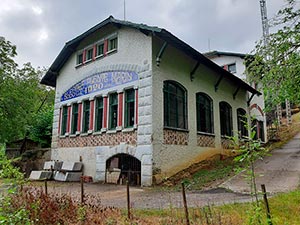Hydroelectric power plants in the Bidasoa basin
Mugaire Central
The Mugaire power plant is easily accessible next to the junction where the N-121 A and B roads converge. Water is taken at two points: the Marín stream, four kilometers away, and the Zeberia stream, just to one side of the Ubaun power plant, five and a half kilometers away. The penstock, which runs 268 meters to bridge the drop from the loading chamber, is clearly visible behind the powerhouse.
Electra Puente Marín put this plant into operation in 1920 to expand its production capacity. With an installed power of 1,200 Kw, Mugaire did not have the magnitude of Almandoz (2,160), but it was among the five largest power stations in Navarra in 1927, only surpassed by Olaldea and Añarbe (Goizueta), owned by La Papelera Española, and Zudaire, owned by Cementos Portland.
The architectural style of the powerhouse differs completely from that of the Almandoz power plant, as it has undergone a creative transformation with modernist echoes through an intricate mix of shapes, colors and materials. The building, located on a slope, is distributed in two parts: a horizontal development machine conference room , which houses three generation groups, and a two-story tower for the transformation elements and output lines. Ventilation and lighting are provided by four large windows with segmental arches -one of them is the access door on the eastern façade- framed by rustic mock-barrels -absent on the western façade- and set in red sandstone masonry.
More original is the short façade, presided over by a modernist ceramic sign with the name of the owning company and the year of inauguration in yellow letters on a blue background. This sign is delimited by a wide segmental arch formed by voussoirs of rustic pilaster, a finish that is also used to flank the facade. The openings are distributed on two floors: a gallery of six tall, narrow windows separated by red brick pillars, on which the ceramic decorated pediment rests, and a four-partite gallery of square windows under the eaves.
Inside, there is a double staircase with an elegant wrought iron railing leading to the control panel. As usual, the roof is a double-sloped iron frame, which on the outside is made of wood with a wide overhang and supported by brackets. The carpentry of the roof, the door and the windows is green, which contributes to the lively chromatic variety of the building.
The compositional freedom of the complex makes Mugaire one of the most interesting power plants in Navarra. It is the first link in a series of projects linked to the engineer Miguel Berazaluce, with similar elements and finishes, especially the large ceramic sign with the name of the business, which continues with the enlargement of Eguíllor (Aguas de Arteta, 1926) and San Fausto in Eraul (Hidráulica del Urederra, 1929).
ALEGRÍA SUESCUN, D., "El molino harinero de Zubieta. Evolución histórica", in Notebooks of ethnology and ethnography of Navarren.º 82 (2007), pp. 5-15.
APEZTEGUÍA ELSO, M. and IRIGARAY SOTO, S., "El Ecomuseo del Molino de Zubieta (Navarra): experiencia pionera en la recuperación y musealización de una instalación preindustrial", in Museum: Magazine of the association Profesional de Museólogos de España (Professional Association of Museologists of Spain)No. 4 (1999), pp. 181-192.
BERAZALUCE ELCARTE, M., "La industria hidro-eléctrica en Navarra", in Rafael Guerra (ed.), Navarra. Ayer, hoy y mañana, Pamplona, Diputación Foral de Navarra, 1933.
HERREROS LOPETEGUI, S. (coord.), Centrales Hidroeléctricas en Navarra (1898-2018), Pamplona, Gobierno de Navarra, 2020.
Map of status based on El agua en Navarra, Pamplona, Caja de Ahorros de Navarra, 1991.











